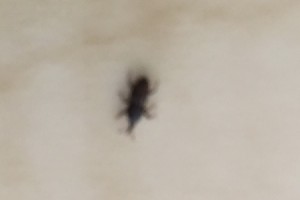 For anyone who could recognize and give any advise about our kitchen newcomers (about 2-3 mm long) will be our huge gratitude. It seems to me they came to us with beech-wheat. Thanks in advance!
For anyone who could recognize and give any advise about our kitchen newcomers (about 2-3 mm long) will be our huge gratitude. It seems to me they came to us with beech-wheat. Thanks in advance!
Add your voice! Click below to answer. ThriftyFun is powered by your wisdom!
These are beetles for sure and they come in flour and beech wheat. You'll need to get rid of all these boxes and clean out your cupboard good. Otherwise, you'll end up throwing a lot more food away in the long run. If you know what store you purchased the beech wheat from take the bag back to the store and notify them they have beetles in their food.
This looks like some kind of pantry beetle. You will have to throw a lot of food out, clean the cabinets with a diluted bleach solution, and store new food in airtight containers.
Thanks very much to all my respondents. - I didn't expect that there are so many people with such a good knowledge and will to help.
Now I hope all is OK - we have thoroughly cleaned our kitchen and all shelves from the remains of grains, grits, muesli and floury products.
I copied this from wiseGeek, as that critter there in the picture seems to have a longer 'muzzle/snout' which helped make it a bit more identifiable (possibly).
Several bugs are commonly referred to as flour weevils. One can be found laying eggs in home stores of flour, cereal, and other grain products. This type is called a flour weevil, but is physically more a beetle, and more accurately known by its other name of flour beetle.
*Another type of pest that thrives on stored grain products is the grain weevil, which has the characteristic long muzzle of a true weevil.*
In a true weevil, the head of the bug is tapered into a long snout.
It is the difference in the head that defines the difference between a weevil and a beetle.
The two types of pests commonly referred to as the flour weevil are actually beetles: the flour beetle and the red flour beetle. Grain weevils are more commonly seen in agricultural settings where large amounts of grain are kept for feed or processing.
It is possible to have a home infestation of true weevils; these are usually brought into the home in products like dry pet foods, birdseed, and ornamentals, such as gourds.
Adult flour beetles, or flour weevils, infest grain products such as flour, cereal, and even pet food that has been stored in the home or in stores. Eggs are laid, and the larvae emerge in the form of small, pale brown worms. These worms have earned the flour beetles the more popular name of flour weevil, as the larvae of the flour beetles look extremely similar to the larvae of true weevils.
These flour weevils can live for years in a warm climate, and a female can lay hundreds of eggs during her lifetime. Larvae are pale in color, but adults are dark, shiny, and reddish-brown. These adults have an oval shape similar to the body of a true weevil, but lack the elongated head. The flour beetle and the red flour beetle both have wings, whereas the true grain weevil does not. A similar type of weevil, the rice weevil, does have wings.
Keeping the kitchen free of flour weevils can require a thorough cleaning and disinfecting once they have been found. Leaving open boxes on the shelves for long periods of time can increase the chance of flour weevils, so sealing grain products in plastic containers can go a long way in helping to prevent infestation. Any boxes that have been contaminated should be immediately discarded away from the home to keep the bugs from returning.
Flour weevils of all kinds can leave the product of the original infestation and spread to other areas of the home.
For future reference, after you cleaned and gotten rid of all your "bugs" (it is really very difficult to remove all larva/eggs) try dusting some Diatomaceous Earth (DE) (Food Grade Only) in the backs and sides of your cabinets. Also under your kitchen sink to help keep all future bugs away.
This is safe for humans and pets. Of course, as with most anything, safety steps should be taken.
Here are a couple of links that explain the uses for DE.
Add your voice! Click below to answer. ThriftyFun is powered by your wisdom!